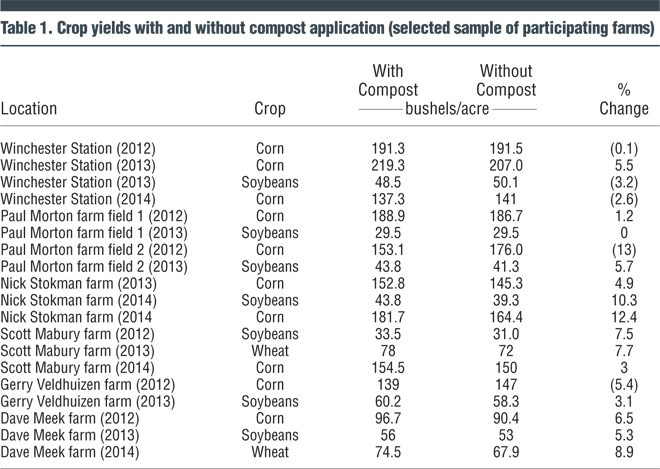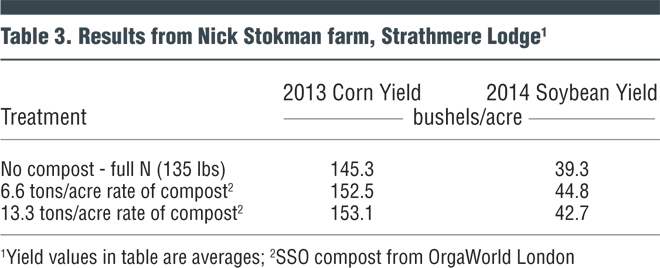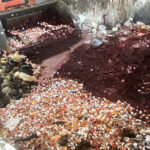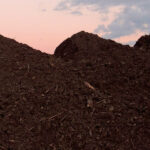Results find compost benefits are dependent on soil type, crops being grown and their nitrogen requirements, the soil’s need for organic matter and the weather.
Peter Gorrie
BioCycle June 2015
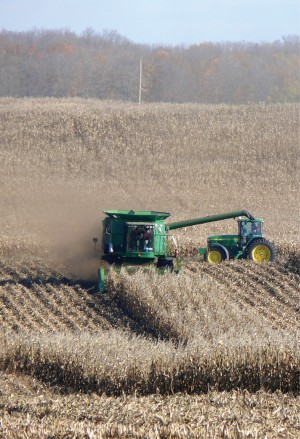
Crops that need a lot of nitrogen, such as corn (above), may need commercial fertilizer in addition to compost. For orchard crops, such as cherries and apples, compost alone can provide all necessary fertilization.
Developing compost markets is crucial for municipalities across North America as they divert increasing volumes of residential source separated organics and leaves and yard trimmings from disposal. In Ontario, Canada’s most populous province, organics collection is growing by nearly four percent annually, with diversion now exceeding 1.1 million tons.
Most of the resulting compost goes into urban horticulture, with some used for erosion control, but those markets can’t consume the growing volume. “If every municipality had a collection program, they’d have more compost than what the urban market could bear,” says Christine Brown, a nutrient management specialist with Ontario’s Ministry of Agriculture, Food and Rural Affairs (OMAFRA). To assess agriculture markets for this growing volume of compost, Brown has been conducting research trials on farms since 2012. (See “Crop Trials Evaluate Green Bin Compost,” June 2013).
“Our organics program produces compost that needs to be marketed,” says Larry Conrad, manager of waste operations with the Region of Peel, a suburban municipality northwest of Toronto that is supporting the trials. “The agricultural market is essential for us.”
In turn, compost should benefit agriculture, helping to offset several trends — including a reduction in the number of farms with access to livestock manure, larger fields, increased tillage and shorter crop rotations — that have combined to reduce the level of organic matter in soils.
“We know compost improves soil health and productivity by returning organic matter and nutrients,” says Susan Antler, executive director of the Compost Council of Canada, which supports the research project. “With this study, we are looking to also find the economic equation that will allow this addition to happen.”
Brown’s preliminary conclusion from the research trials is that “in general, the addition of organic amendments has increased the crop yield in the fields where they were applied.” These short-term yield benefits, however, appear to depend on the compost’s ingredients and maturity, application rates, farm management practices, soil type, weather and the crop. And while compost provides impressive soil benefits — moisture retention, microbial activity and erosion control — that are even more significant than the nutrients it delivers and that commercial fertilizer doesn’t supply, the benefits aren’t immediate and are difficult to quantify in the year of application. And the cost of using compost can be higher as compared to manure or commercial fertilizer.
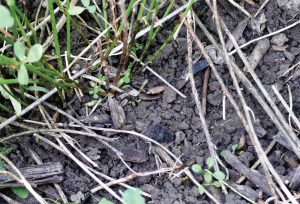
In general, notes researcher Christine Brown with OMAFRA, the addition of organic amendments has increased the crop yield in the fields where they were applied. Photos courtesy of Christine Brown, OMAFRA
All this suggests the agricultural market’s growth will depend on whether farmers will pay compost’s higher up-front cost in return for benefits that could take several years to materialize and are difficult to quantify. Interviews with study participants revealed widespread concern about this conundrum. Most echoed Nick Stokman, who got good immediate results with compost on corn and soybeans on the 65-acre farm he manages near the town of Strathroy, in southwestern Ontario: “Certainly the agronomy is there. As for the economics, I don’t know. But they will be the determining factor.”
Expanded Field Trials
Ontario requires municipalities with more than 50,000 residents to have separate collection of leaves and yard trimmings, but residential source separated organics (SSO) programs (targeting food scraps and other compostables) are voluntary, as is reporting how much material is picked up. Waste Diversion Ontario, the nonprofit, industry-funded organization that oversees all of the province’s recycling programs, keeps tabs on the data that do come in. Its latest figures (for 2013) indicate that total collections of residential SSO and leaves and yard trimmings by 110 municipalities (reporting voluntarily) — representing more than 3.8 million households — exceeded one million tons. Organics collection increased by an average of 3.9 percent annually between 2008 and 2013.
Brown got involved with compost evaluation through informal tests conducted by a few farmers seeking an alternative to manure or commercial fertilizer. Then, the Compost Council of Canada and Peel Region contacted her about doing a bigger, formal set of trials. She lined up farmers from across southern Ontario who were willing to participate, as well as seven producers who agreed to provide compost. Five of the sources compost a combination of SSO and yard trimmings. One also composts digestate from Toronto’s anaerobic digester and another processes only yard trimmings.
Each producer’s compost was analyzed in advance to help determine the best application rate. In addition, samples of the compost actually applied were assessed to allow more accurate applications of commercial nitrogen and and to help verify the plant tissue and soil sampling that occurs after the compost has been applied.
Compost was made available at little or no charge, although some of the farmers had to cover the transportation and application costs. Financial support came from several sources, including the Green Municipal Fund, established by the Federation of Canadian Municipalities with a federal government endowment to support “innovation and leadership in municipal sustainable development,” and the OMAFRA Best Management Practices Demonstration and Verification Program. Support for compost, soil, plant tissue and biological testing came from A & L Laboratories Canada Inc. of the trials was to conduct side-by-side comparisons and assess the resulting economic implications, the procedures varied from site to site, reflecting local conditions, crops and farming practices. Some generated hard data on yields; others didn’t do measured comparisons and produced observational evidence. Weather presented further complications: The first growing season, 2012, was hot and dry. Last year was so wet and cool that many crops suffered no matter how they were treated.
Formal multiyear tests have been conducted at four sites, with replicated, side-by-side comparisons, sampling and monitoring. Another five sites had such comparisons for one year but poor harvest weather and other issues prevented subsequent crop harvest follow-up data.
The formal tests were conducted on field-scale areas of farmland divided into strips, carefully located by GPS and labelled. Each strip received a different treatment, with compost and commercial fertilizer applied at varying amounts per acre, either alone or in combinations. As a control, some strips were not treated at all. At most sites, compost was applied just at the beginning of the trial. Usually, none was applied the following years, a methodology intended to allow assessment of its residual effects.
However, as part of the trial design, most farmers applied commercial fertilizer to all their test strips during the second and third years based on crop recommendations to ensure the plants got adequate nutrition. Treating the entire area consistently, with the same amount of commercial fertilizer on each plot, still let them observe any impacts of the original compost applications.
At most sites, corn was grown the first year of the trials, followed by soybeans, then, either winter wheat or, once again, corn. Compost was also tested on hayfields and one strawberry farm. In addition, although not part of the official trials, one farm applied compost on a large apple and cherry orchard.
Researcher And Farmer Observations
Data are available from some sites (Table 1), while all the farmers have provided valuable observations based on their individual experiences. The main conclusions:
Performance In Sandy Soils: In general, compost provided the greatest benefit on light, sandy soils with poor fertility, as well as in warm, dry growing seasons — conditions that highlighted its ability to hold moisture and to stimulate microbial activity. A case in point is Scott Mabury, who recorded some of the trials’ best results on light, sandy soil that had been overworked to infertility by previous farmers. The compost was made from residential SSO and yard trimmings at a Miller Waste Systems Inc. facility about 60 miles away from Mabury’s farm. It was applied to his test plots; corn yields rose by 5.5 bushels per acre, soy by five bushels and wheat by 15. These are actual yield increases; Table 2 provides average yields.
Impact of Feedstock Types: The impact on yields also depended to some extent on the compost’s composition: The best immediate results came from the nitrogen-rich compost produced mainly from residential SSO. If the compost feedstock contained a higher proportion of leaves and yard trimmings, and thus carbon, yields didn’t increase significantly and in a couple of cases declined because the nitrogen the crops needed was tied up in trying to decompose the carbon.
Stokman’s results at his Strathmere Lodge farm demonstrated this effect. The strip treated with compost from TRY Recycling, comprised entirely of leaves and yard trimmings, produced corn at a rate of 145.3 bushels per acre. With commercial fertilizer applied at the recommended 130 pounds per acre, the yield rose to 182.5 bushels. The strip treated with compost produced by London-based Orgaworld Canada Ltd., which had a higher proportion of residential SSO, yielded 198.3 bushels. Table 3 shows the average yield for both compost types combined.
Use Of Commercial Fertilizer: Use of commercial nitrogen fertilizer may be necessary, primarily because compost may not provide enough nutrients on its own and the nutrients it does provide may not be released consistently and predictably. However, the trial participants’ experiences and opinions varied widely, in part because some crops need more nitrogen than others, Brown explains. Corn requires a lot of nitrogen from mid June to pollination. Often the soil microbiology just can’t cycle enough nitrogen fast enough to meet that crop’s needs, especially in a cold, wet year. “So we always recommend some commercial nitrogen for corn and wheat crops,” she adds. “Other crops, especially horticulture crops, don’t need a lot of nitrogen. In fact, too much will have a negative impact on quality. These were some of the things we were trying to document in the study with rate and timing of application.”
Brett Schuyler’s family operates an orchard as well as grows cash crops. He reports that light annual applications of compost have completely replaced commercial fertilizer for the cherry and apple trees while the corn gets the same fertilizer treatments it always has.
Dave Meeks, who raises cash crops on 1,200 acres northwest of Toronto, found that yields on plots that received a high rate of compost, up to 22 tons/acre, and a standard rate of commercial fertilizer did as well as those treated with the same amount of compost but half the fertilizer. “That suggests you can get away with less commercial fertilizer,” he says.
How much to apply depends on the results of soil tests, explains Dave Curry, the agronomist for Parkland Farms, a family business that grows mainly cash crops on 12,000 acres of owned, rented or shared land scattered throughout Lambton County in southwestern Ontario. “We vary the rate of application based on that. On some farms we can reduce fertilizer by 100 percent; on others, we’re only going to cut back 50 percent.” The amount of commercial fertilizer used might fall further in the future as the compost slowly releases nitrogen.
Gerry Veldhuizen, who raises cash crops on 800 acres near the east end of Lake Erie’s north shore, uses compost to gradually build up his soil but doesn’t count on it for nutrients. “When I apply the compost I don’t give it any credit for fertility,” he says. Instead, he considers it a deposit into what he calls his soil bank. “I balance what I’m taking up and putting in with commercial fertilizer. Any fertility from the compost goes in the bank. You’re always looking to build soil.”
Cost Factor: Many participants stated that they wouldn’t use compost at full cost, or just need to target where it is utilized. Because compost costs him $300/acre, Veldhuizen can’t afford to apply it on his entire farm. Instead, he targets lower-yielding fields that lack soil structure and organic matter, “to make them more productive over time.”
Frank Peters operates a small farm and also manages the AIM Environmental Group’s composting facilities in Hamilton and Guelph that, combined, produce 24,300 tons of compost annually from 97,000 tons of organic wastes. He has found that if he can convince farmers to try compost, they’ll continue to use it. It’s easier, he notes, to sell the idea to those who have previously treated their land with manure, since it shares many qualities — although not its strong odor — with compost.
Mike Lishman, who farms south of Hamilton, has used compost for eight years and is convinced of its benefits. He also supplies services to other farmers, including applying compost, and reports a positive response. “I’ve never had a customer take it and not use it again,” he says.
Long Term Perspective
Using compost involves a long-term commitment to building soil, says Scott Banks, an OMAFRA field crop specialist who led field trials at the Winchester Agricultural Station in Eastern Ontario, a satellite of the University of Guelph. “It’s not usually a short-term route to better yields. Not that there isn’t value in terms of building organic matter, but you’ve got to do that long-term. Any farmer using compost would have to be thinking long-term: It builds over time instead of an immediate response. The bottom line for growers is that when it comes to yield response, you’re not going to see it in the first few years.”
Susan Antler of The Compost Council of Canada notes that the crop trials research confirms that “we have the fundamental truth on our side: productive soil needs to be rich in organic matter. This will facilitate the advancement of agricultural markets for compost. “
Brown remains optimistic: “Agriculture will be an important market for compost,” she explains. “I’m a big fan of diverting organic waste from landfill and putting it back on agricultural land. Here’s an urban source that farms could have access to.”
But, she notes, the tests help to show that “it’s not by itself the magic bullet. It’s compost combined with good farming practices — good crop rotations, cover crops, minimal tillage, and keeping residual material (such as corn stalks) in the field. They provide a synergistic effect for improving soil quality.”
With additional funding from Peel Region’s “Green Municipal Fund” the trials will continue for another year, Brown says. “This is important for the economic and soil health improvement documentation.”
Peter Gorrie is a Contributing Editor to BioCycle.
